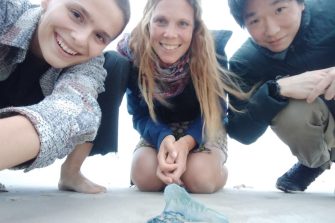Bluebottle Watch

Many Australians have had a painful bluebottle sting, yet little is known about bluebottles and what brings them to the coast. This project will shed new light on bluebottle dynamics, pathways, and distribution of bluebottle beachings.
We will use an innovative combination of lab work, ocean surveys, statistical and hydrodynamic modelling to fill knowledge gaps and ultimately develop the first bluebottle risk prediction tool for our popular beaches in partnership with Surf Life Saving Australia (SLSA).
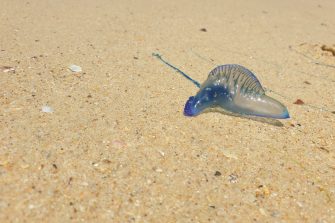
About the bluebottle
Church et al (2025) identified different species of Physalia, showing the bluebottles is actually not the same species as the Portuguese Man of War in the Atlantic, Physalia physalis (updating the classification from the Global Biodiversity Information Facility).
The bluebottle (and any other Physalia species) is not a jellyfish, but a fascinating colonial organism (called a Siphonophore) found predominantly in tropical and subtropical regions. In the Atlantic, Physalia is larger and more venomous and believed to live for around a year, although this is still being confirmed (Munro et al 2019).
The bluebottle does not swim, but floats at the ocean’s surface and trails a stinging tentacle up to meters below the surface. The gas-filled ‘pneumatophore’ that floats on the ocean surface (1-15cm) acts as a ‘sail’ that is subject to wind forces. The sail is oriented to the left or right of the body of tentacles, resulting in individual bluebottles being either right-handed or left-handed, respectively. Why? Well, since the sail/float orientation plays a role in determining bluebottle drift due to the wind direction, right and left-handed individuals will not all drift in the same direction. This well-designed morphological and behavioural adaptation is thought to ensure half the population avoid potential death if beached on the shore.

Citizen science: Have you seen a Bluebottle?
We need your help!
If you see a bluebottle on the beach, first don’t touch its tentacles! They can sting even when it’s dead.
Please take a photo and upload it to iNaturalist platform, ideally using a top view and with an indication of the length of the float (include your finger in the photo or estimate the length as shown with the red line in the figure below.
Finally, if you have a scientific mind, join our iNaturalist project, where you can add an estimate of the abundance, the size, and the handedness of the bluebottle.
Link to our project on iNaturalist here.
Watch this tutorial on how to use iNaturalist here.
Is it right or left-handed? When pointing forward, away from you, with the float at the top, the dark blue bulge of the tentacles is to the right of the float for right-handed bluebottles, or to the left of the float for left-handed bluebottles.
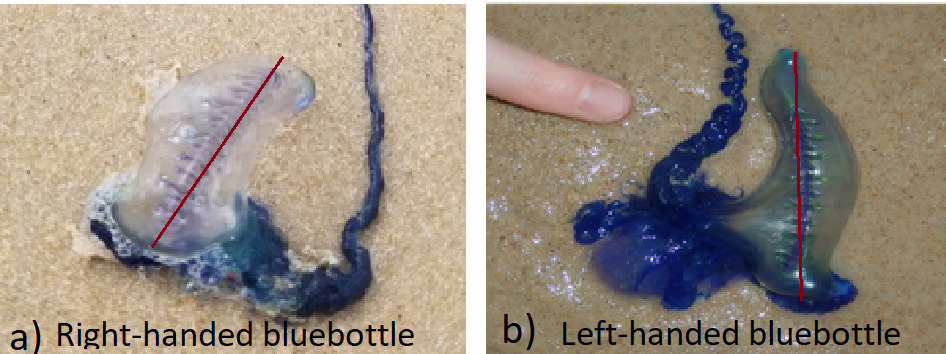
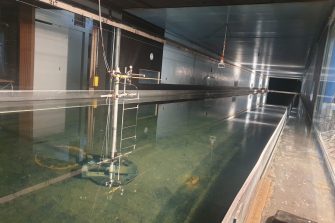
Lab experiments in a wind tunnel
There are so many things we can do nowadays with a 3D printer!
We created realistic plastic and silicone bluebottle floating replicas to test how they move in a lab, in response to controlled winds. The movement of the bluebottle is unique, in that it is determined by an interplay of morphological characters and environmental drivers.
Previous research from the 1960s used observational studies at sea to explore the unusual drifting angle of bluebottles relative to the wind speed and direction (Totton and Mackie, 1960). This research concluded that Physalia was horizontally transported (a.k.a. advected) ±40 degrees downwind for weak winds, with this angle decreasing for stronger winds.
We explored this more extensively in a lab (and under lots of different conditions) using a controlled wind / wave tunnel facility, confirming the theory and quantifying the drift characteristics of the bluebottles. Then, we tested our 3D-printed replicas in the ocean, under real conditions.

The bluebottle in an aquarium
Have you ever seen a Bluebottle in an aquarium? The answer is most likely no since no one has managed to keep them alive for more than a couple of months.
This is the challenge we are taking on in collaboration with Sea World and the Griffith Sea Jellies Research Laboratory: including the development of a bluebottle-specific tank to add to the beautiful Sea Jellies illuminated exhibit at Sea World.
We will also use this new tank for scientific experiments. In particular, we want to study the behaviour of the bluebottle in response to changes in winds and temperature, such as the rolling behaviour, the contraction of the float, and coiling of the tentacle.
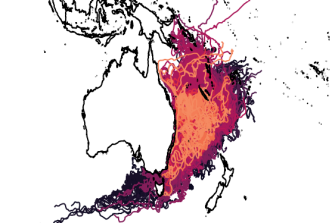
Numerical particle tracking
Satellite tags are not yet small and light enough to attach to bluebottles. Most of the knowledge about the pathways of passive material in the ocean (e.g. larvae or plastics) comes from drifting buoys experiments, or from numerical simulations.
Numerical particle tracking uses estimates of wind and ocean current speed and direction at the surface to move a particle around. Our ‘particle’ has similar characteristics to a bluebottle. We use purpose built bluebottle module (Lee et al, 2022 a,b, Bourg et al, 2024), to estimate how the wind and ocean currents move the particle at each time step.
The source of bluebottle swarms is unknown. Particle tracking can also be reversed to "backtrack" the bluebottle like particles, and hence finally understand where they come from. Are the Tasmanian bluebottles coming from the Great Barrier Reef? The answer is coming soon!
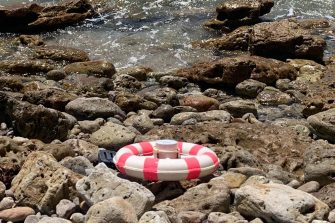
Field surveys: finding the Bluebottle
We are monitoring the presence / absence of bluebottles on the beach during summer months, and how it varies from one day to another, and one beach to another. Recording the abundance, shape, size, and handedness of the bluebottles will also help us to understand their population dynamics. Ultimately, we will link the arrival of bluebottles to shore to environment variables and create a statistical machine learning model to forecast their distribution along the coast.
Attaching a satellite tag to a bluebottle without affecting its floatability is not yet achievable. What we can do, however, is to track other drifters to understand how objects move at the interface between the ocean currents and the wind, and equip 3D-printed bluebottle replicas with a GPS to see where they end-up beaching.
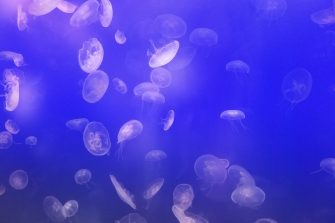
Media
Media featuring our project
- 29 Oct 2025 | The secret lives of bluebottles: Another weird organism | UNSW Science Substack
- June 2025 | Australian Lifeguard Magazine | Issue 15 pages 18-19
- 17 Dec 2024 | Escaping the summertime blueys | UNSW Newsroom
- 20 Mar 2024 | ABC breakfast Illawarra Radio: https://www.abc.net.au/listen/programs/illawarra-breakfast/illawarra-breakfast/103590552
- Feb 2024 | BluebottleWatch’s French collaborators joined our Sydney team in January 2024 to test the 3D-printed bluebottle models they designed in real ocean conditions. The fieldwork off Botany Bay was a great success, described in detail here: https://www.mio.osupytheas.fr/en/bluebottle-watch.
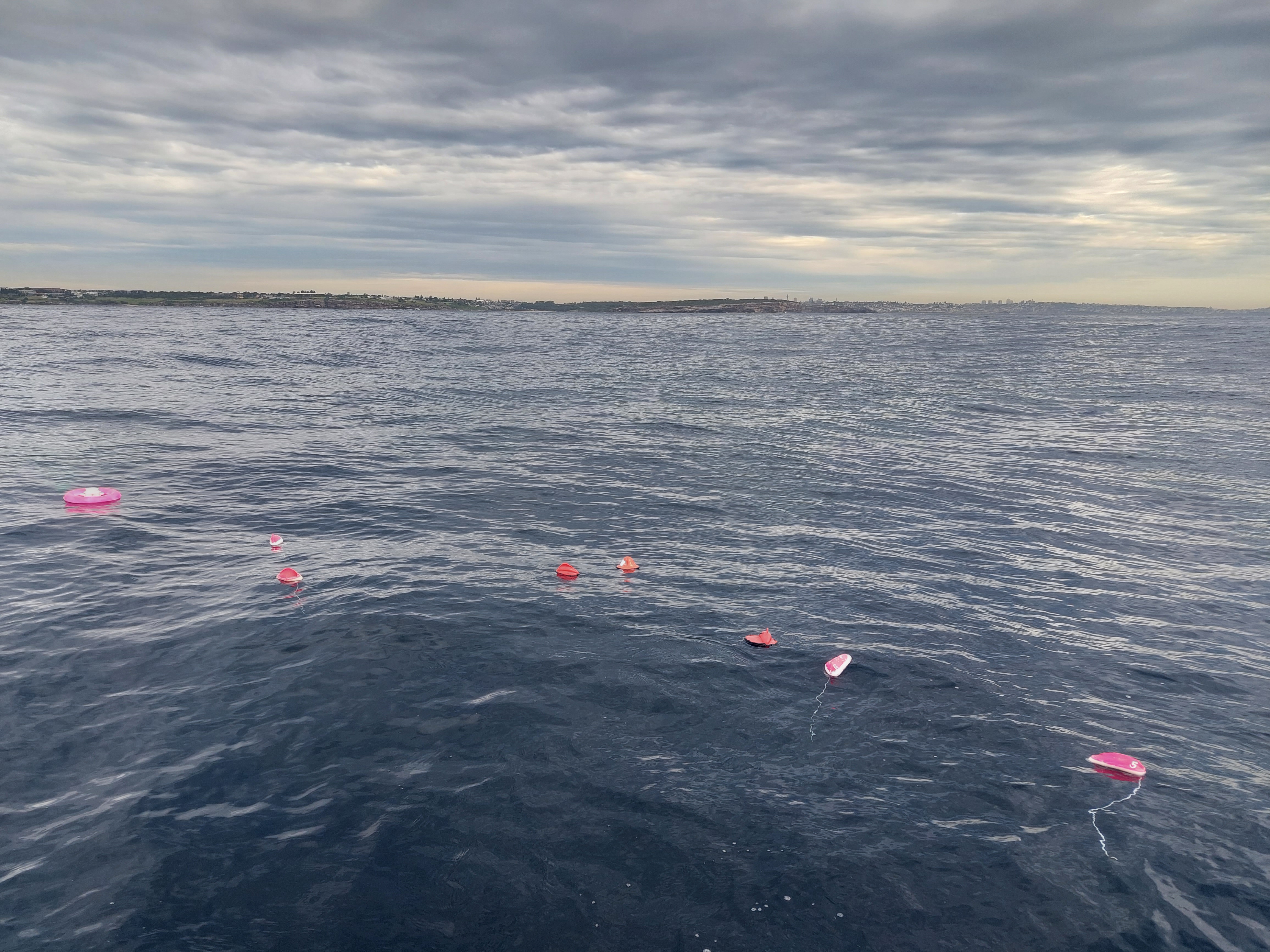
- Feb 2024 | Experts debunk popular bluebottle sting remedy - but not the one you think
- Aug 2023 | Boiling Point podcast on bluebottles with Kim Porter and Maxime Arnaud: https://soundcloud.com/user-982894834/whats-blind-buoyant-and-brainless-bluebottles
- July 2023 | Beachgoer shocked by 'massive' bluebottles washed up on Aussie coast
- March 2023 | BluebottleWatch was on display during the Ocean Lovers festival in Bondi beach. Primary and high-school students, as well as the general public, were able to learn more about the bluebottle’s handedness, see how 3D-printed bluebottle models in a tank move in response to wind forcing, and discover how they can use the citizen science project to record their encounter with bluebottles (https://inaturalist.ala.org.au/projects/bluebottles-in-australia-physalia-physalis ). We hope to see your bluebottles’ photos there soon!
.jpg)

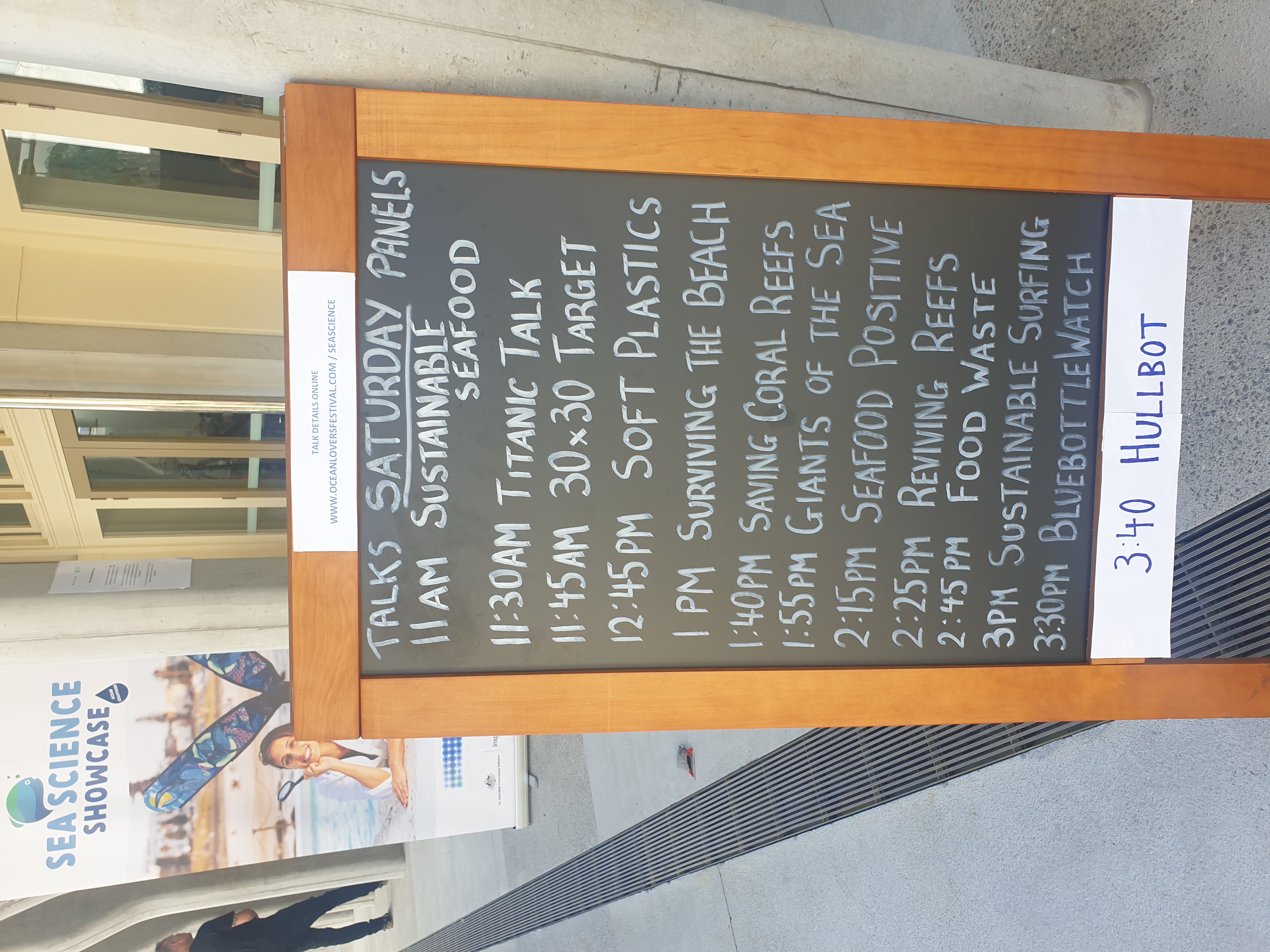
- Dec 2022 | The Sydney Morning Herald | Scientists develop early warning tool to predict bluebottle invasions
- 7 Dec 2022 | 2ser 107.3 Radio: Bluebottles
- 1 Dec 2022 | SLS: BluebottleWatch: A new research project to develop a bluebottle prediction tool for our beaches
- 7 Oct 2022 | The Guardian: Spring has stung: thousands of bluebottles wash up on Sydney beaches
- 28 March 2022 | The Conversation: Want to avoid a bluebottle sting? Here’s how to predict which beach they’ll land on
- 22 February 2021 | IMOS OceanCurrent: Drifting to shore
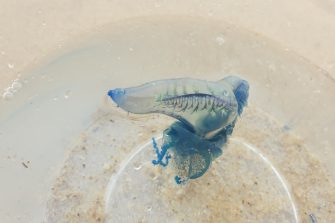
References
Our References
Amuche Ibenegbu and Amandine Schaeffer and Pierre Lafaye de Micheaux and Rohitash Chandra, 2025, A Machine Learning Framework for Handling Unreliable Absence Label and Class Imbalance for Marine Stinger Beaching Prediction, preprint https://arxiv.org/abs/2501.11293
Bourg N, Schaeffer A, Cetina-Heredia P, Lawes JC, Lee D (2022) Driving the blue fleet: Temporal variability and drivers behind bluebottle (Physalia physalis) beachings off Sydney, Australia. PLOS ONE 17(3): e0265593. https://doi.org/10.1371/journal.pone.0265593
Bourg N, Schaeffer A, Molcard A, Luneau C, Hewitt DE, Chemin R. Ocean wanderers: A lab-based investigation into the effect of wind and morphology on the drift of Physalia spp. Mar Pollut Bull. 2024 Oct;207:116856. doi: https://doi.org/10.1016/j.marpolbul.2024.116856
Bourg, N., Schaeffer, A., & Molcard, A. (2024). East Australian Current system: Frontal barrier and fine-scale control of chlorophyll-a distribution. Journal of Geophysical Research: Oceans, 129, e2023JC020312. https://doi.org/10.1029/2023JC020312
Daniel E. Hewitt, Amandine Schaeffer, Jasmin C. Lawes, Sean Kelly, Alistair G.B. Poore, Moninya Roughan, Saima Ajaz, Timothy C. Ingleton, Kylie A. Pitt, 2026 Blowin’ in the wind: Onshore winds drive the occurrence of bluebottles (Physalia spp.) at east Australian beaches, Ocean & Coastal Management, Volume 271, 107931, ISSN 0964-5691, https://doi.org/10.1016/j.ocecoaman.2025.107931
Global genomics of the man-o’-war (Physalia) reveals biodiversity at the ocean surface. Samuel H. Church, River B. Abedon, Namrata Ahuja, Colin J. Anthony, Diego A. Ramirez, Lourdes M. Rojas, Maria E. Albinsson, Itziar Álvarez Trasobares, Reza E. Bergemann, Ozren Bogdanovic, David R. Burdick, Tauana J. Cunha, Alejandro Damian-Serrano, Guillermo D’Elía, Kirstin B. Dion, Thomas K. Doyle, João M. Gonçalves, Alvaro Gonzalez Rajal, Steven H. D. Haddock, Rebecca R. Helm, Diane Le Gouvello, Zachary R. Lewis, Bruno I. M. M. Magalhães, Maciej K. Mańko, Alex de Mendoza, Carlos J. Moura, Ronel Nel, Jessica N. Perelman, Laura Prieto, Catriona Munro, Kohei Oguchi, Kylie A. Pitt, Amandine Schaeffer, Andrea L. Schmidt, Javier Sellanes, Nerida G. Wilson, Gaku Yamamoto, Eric A. Lazo-Wasem, Chris Simon, Mary Beth Decker, Jenn M. Coughlan, Casey W. Dunn; bioRxiv 2024.07.10.602499; doi: https://doi.org/10.1101/2024.07.10.602499
Lee, D., Schaeffer, A., and Groeskamp, S.: Drifting dynamics of the bluebottle (Physalia physalis), Ocean Sci., 17, 1341–1351, https://doi.org/10.5194/os-17-1341-2021, 2021.
Natacha Bourg PhD. Interactions between boundary currents, fronts and eddies in the Northern Current and the East Australian Current. : Transport dynamics and application to the journey of Physalia spp.. Oceanography. (2024) Université de Toulon. English. https://theses.hal.science/tel-04910186
Samuel H. Church, River B. Abedon, Namrata Ahuja, Colin J. Anthony, Dalila Destanović, Diego A. Ramirez, Lourdes M. Rojas, Maria E. Albinsson, Itziar Álvarez Trasobares, Reza E. Bergemann, Ozren Bogdanovic, David R. Burdick, Tauana J. Cunha, Alejandro Damian-Serrano, Guillermo D’Elía, Kirstin B. Dion, Thomas K. Doyle, João M. Gonçalves, Alvaro Gonzalez Rajal, Steven H.D. Haddock, Rebecca R. Helm, Diane Le Gouvello, Zachary R. Lewis, Bruno I.M.M. Magalhães, Maciej K. Mańko, C. Gabriela Mayorga-Adame, Alex de Mendoza, Carlos J. Moura, Catriona Munro, Ronel Nel, Kohei Oguchi, Jessica N. Perelman, Laura Prieto, Kylie A. Pitt, Moninya Roughan, Amandine Schaeffer, Andrea L. Schmidt, Javier Sellanes, Nerida G. Wilson, Gaku Yamamoto, Eric A. Lazo-Wasem, Chris Simon, Mary Beth Decker, Jenn M. Coughlan, Casey W. Dunn (2025) Population genomics of a sailing siphonophore reveals genetic structure in the open ocean, Current Biology, Volume 35, Issue 15, 2025, Pages 3556-3569.e6, ISSN 0960-9822, https://doi.org/10.1016/j.cub.2025.05.066
https://os.copernicus.org/articles/17/1341/2021/os-17-1341-2021-corrigendum.pdf
Other references
Munro, C., Vue, Z., Behringer, R., and Dunn, C.: Morphology and development of the Portuguese man of war, Physalia physalis, Sci. Rep.-UK, 9, 15522, https://doi.org/10.1101/645465, 2019

